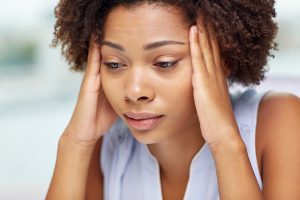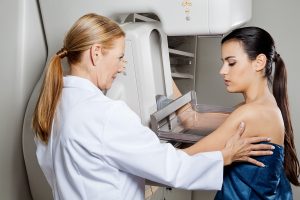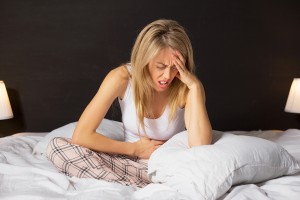Dr. Pamela W. Smith gave a talk about new treatments for premenstrual syndrome (PMS). She presented this talk on Dec. 11 at the 24th Annual World Congress on Anti-Aging Medicine (Dec. 9-11, 2016) in Las Vegas that I attended. The original title was “New Treatment Modalities for PMS”.
Signs and symptoms of PMS
Dr. Smith discussed signs and symptoms of PMS first. She showed 9 slides where she listed all of the symptoms of PMS that commonly occur.
Symptoms are varied; they can mimic various psychological problems like anxiety, depression, panic attacks and more. But physical symptoms like abdominal bloating, acne, back aches, and asthmatic attacks are also common. There are a myriad of more symptoms of PMS: constipation, cramps, clumsiness, dizziness, drowsiness, decreased sex drive, facial swelling, forgetfulness, fatigue, headaches, a herpes-like outbreak, hot flashes, sensitivity to light and noise, insomnia, joint pains, mood swings, palpitations, restlessness, poor memory, sore throat, tearfulness, vomiting and weight gain.
What do we know about PMS?
PMS is due to a hormone dysfunction
There is no definitive test that would help in the diagnosis of PMS. But we do know that there is a hormone dysfunction that leads to a monthly recurrence of symptoms during the two weeks prior to the woman’s menstruation. When her period begins or shortly after all of these symptoms disappear.
PMS due to estrogen dominance
PMS is very common; 70to 90% of women have a certain degree of PMS. In 20 to 40% of women symptoms are severe. Many researchers have shown that there is a problem in the feedback loop between the pituitary gland and the ovaries. This leads to a decrease of progesterone production in the ovaries. The result is an overabundance of estrogen, which many hormone experts call estrogen dominance.
Several hormones need checking with PMS
But things can get complicated when other hormone changes occur. A woman may also turn hypothyroid. When she gets closer to menopause estrogen deficiency may also develop. Electrolyte disturbances can occur from high estrogen levels causing excessive aldosterone levels. This would lead to high sodium and low potassium blood levels. The end result may be an activation of the renin-angiotensin system, which could cause high blood pressure.
Neurotransmitters of the brain can be involved in PMS
Neurotransmitters are often disbalanced. When serotonin is low in the brain, depression can develop. Noradrenalin deficiency leads to a lack of focus, energy and memory.
Women with PMS often have hypoglycemia
Hypoglycemia is also common among women with PMS. This may be due to cravings for sweets and consumption of starchy foods. Women who crave sweets may also consume caffeine excessively. But caffeine increases prostaglandin production in the body. This leads to breast tenderness, abdominal cramping, arthritis and back pains.
PMS after partial hysterectomy
A partial hysterectomy can cause PMS in a woman who never before had symptoms of PMS. The current school of thought is that blood supply to the ovaries after a hysterectomy has decreased, and this could be the reason for the onset of PMS.
Birth control pill can cause PMS
The birth control pill can bring on PMS due to the progestin component in it.
Tubal ligation may cause PMS
Tubal ligations can also be a cause: 37% of women who had tubal ligations develop PMS. The reason is a change in hormone production. In these women estrogen is produced to a higher degree than progesterone is.
Lab tests for women with PMS
Although there is no single test that would be able to diagnoses PMS, a variety of abnormal tests are often abnormal in association with PMS. Frequently there is deficiency for vitamin A, B6, E, magnesium, potassium, zinc and trace minerals. Calcium can be too high or too low, but blood tests will reveal that.
Four PMS types
Dr. Smith said that PMS has been divided into 4 subcategories depending on the main symptoms.
- Anxiety: PMS A
- Carbohydrate craving: PMS C
- Depression: PMS D
- Hyperhydration: PMS H
PMS A is associated with estrogen excess and progesterone deficiency. There is a diminished stress response in the hypothalamus/pituitary/adrenals axis. Symptoms are mainly anxiety, irritability, insomnia and emotional lability.
PMS C is associated with sugar craving, hypoglycemia, headaches, heart palpitations and spontaneous sweating.
PMS D is leading to increased neurotransmitter degradation. Symptoms consist of depression, crying, despair, feeling hopeless, fatigue, low libido, apathy and insomnia.
PMS H is caused by increased aldosterone activity triggered by estrogen surplus in the late luteal phase. Symptoms are weight gain, swelling of hands and feet, a feeling of bloating, breast tenderness or engorged breasts. Women will find that their clothes simply fit tighter.
Migraine headaches in PMS
Some women with PMS are plagued by migraine headaches. It may have started in puberty or after taking birth control pills for contraception. Sometimes the onset is after a pregnancy, miscarriage or abortion. When PMS develops and a woman has migraines, they usually occur around the same time in her menstrual cycle. With pregnancy the migraines disappear in the last trimester when progesterone hormone production from the placenta is the highest.
Hormonally related headaches can occur for 4 main reasons.
- Estrogen and progesterone are on the rise around the time of ovulation
- When a woman has hypoglycemia (due to hyperinsulinemia)
- Estrogen levels are changing
- When there is estrogen dominance
Treatment for PMS
Dr. Smith explained in detail the various treatment modalities for PMS. Treatment has to be personalized according to what type of PMS the doctor thinks that the patient is suffering of.
Dietary factors
In the beginning it is important to pay attention to the diet. Studies have shown that PMS patients tend to eat too many carbs and too much refined sugar compared to patients without PMS. PMS patients also eat too many dairy products and too much sodium. In addition PMS patients are deficient in iron, manganese and zinc. A good start is a Mediterranean diet, which is at the same time anti-inflammatory.
The recommendations is to eat 6 small meals a day. Avoid caffeine and alcohol. They are antagonists to the B complex vitamins. By avoiding sugar, you also avoid fluid accumulation and magnesium deficiency. A low fat, high-complex carb diet helps reduce breast tenderness. Reducing fat and increasing fiber in the diet decreases estrogen levels in the blood. These steps help PMS symptoms.
Nutritional supplements
Magnesium, vitamin B6, A, D3, E, L-tryptophan, calcium, zinc, fish oil (EPA/DHA) and evening primrose oil are the main supplements recommended for PMS patients. Your healthcare provider can advise you what you should take and what dosage.
Exercise
Regular exercise has very beneficial effects on reducing many symptoms of PMS. Even as little as 8 weeks of exercise -as was done in this study- had a significant effect. Exercise elevates endorphin levels, improves blood sugar stability, decreases norepinephrine and epinephrine in the brain and helps to decrease estrogen levels. This will control blood sugar levels, reduce anxiety, reduce estrogen-related symptoms and increase satisfaction.
Thyroid medication
Many women with PMS have borderline hypothyroidism or are overtly hypothyroid. In these cases the patient should receive small amounts of thyroid hormones.
Progesterone
Most PMS patients persistently lack one hormone, progesterone. The best test for this is a saliva hormone test, because this reflects the tissue levels. Blood levels test too low and are useless. Bioidentical progesterone cream is applied transdermally (through the skin) from day 14 to 25 of each menstrual cycle. Micronized progesterone pills are also bioidentical and can take the place of progesterone cream.
Botanicals
There are a number of home remedies, which are heavily promoted on the Internet. They may, however, not be as effective as advertised.
Estrogen balancing Black Cohosh
Black Cohosh is said to balance estrogen and is anti-spasmodic.
Progesterone raising Chasteberry
Chasteberry decreases LH and prolactin. It raises progesterone, acts as a diuretic and binds opiate receptors. This reduces PMS related aches and pains.
Herbal supplement St. John’s Wort
St. John’s Wort helps these symptoms: anxiety, depression, mood swings, feeling out of control and pain.
Anti-inflammatory Ginkgo biloba
Ginkgo biloba is a mild blood thinner. Women who are on blood thinners should not use it! It improves depressive symptoms and mood, has anti-inflammatory effects and helps with anxiety control.
Nutrient-rich saffron
Saffron: In a clinical trial the Saffron group did significantly better in PMS symptom control than the placebo group. Saffron is rich in magnesium, vitamin B6, iron and other nutrients that are missing in PMS patients, which explains the effectiveness of this botanical.
Lavender, Motherwort, and Dandelion
Other botanicals: Other botanicals are Lavender, Motherwort, and Dandelion.
Candidiasis
Due to prolonged exposure to high sugar and refined carb intake many women with PMS suffer from candidiasis (chronic yeast infection). Anti-Candida programs help to eradicate Candida overgrowth, which often improves several PMS symptoms.
Mind/body therapy
Cognitive-behavioral therapy helps for depression and anxiety. Hypnotherapy, yoga and biofeedback therapy are also useful methods.
Conclusion
At the present time there is a better understanding of PMS than in the past. Progesterone deficiency and other hormone weaknesses seem to be at the center of this condition. But vitamin and mineral deficiencies also play a role. The healthcare provider should order some baseline blood tests and hormone tests for the patient, including a saliva progesterone level.
Treatment consists of a combination of steps taken simultaneously. The dietary approach comes first: a Mediterranean diet will be beneficial. Next add nutritional supplements. Regular exercise is essential. Finally bio-identical hormone replacement of the missing hormones is necessary.
If there is an underlying chronic candidiasis infection, it needs treatment. The choice of drug would be nystatin. Some botanicals may be helpful, as discussed. When anxiety and depression are important parts of the PMS symptoms, mind/body therapy (such as cognitive therapy etc.) may also be helpful.
The key with PMS treatment is to not give up, but to re-evaluate the condition, if the initial attempt does not bring full relief. By not giving up and using all modalities of treatment the patient will be able to get rid of the condition, eliminate the symptoms of PMS and achieve well being.










